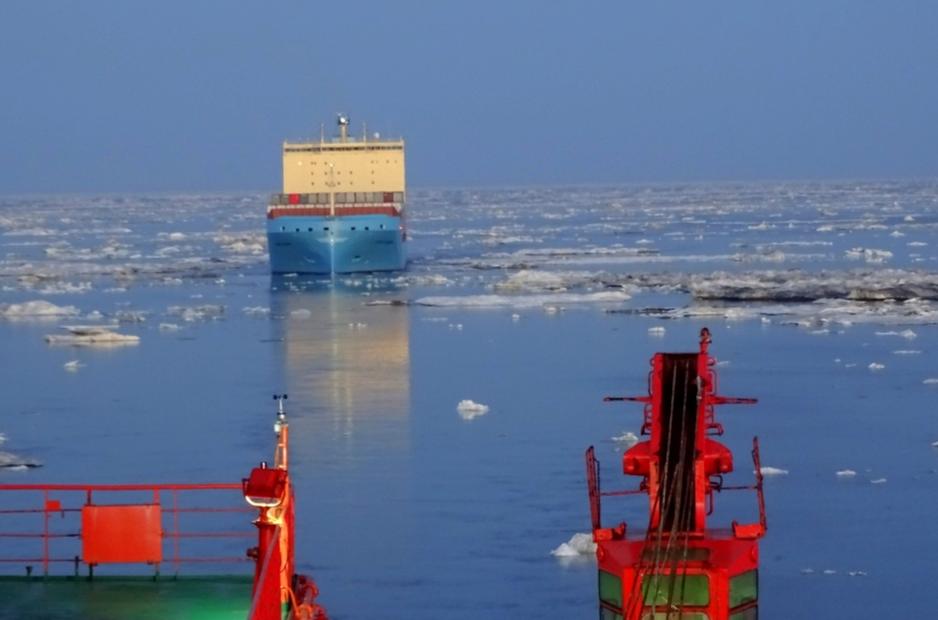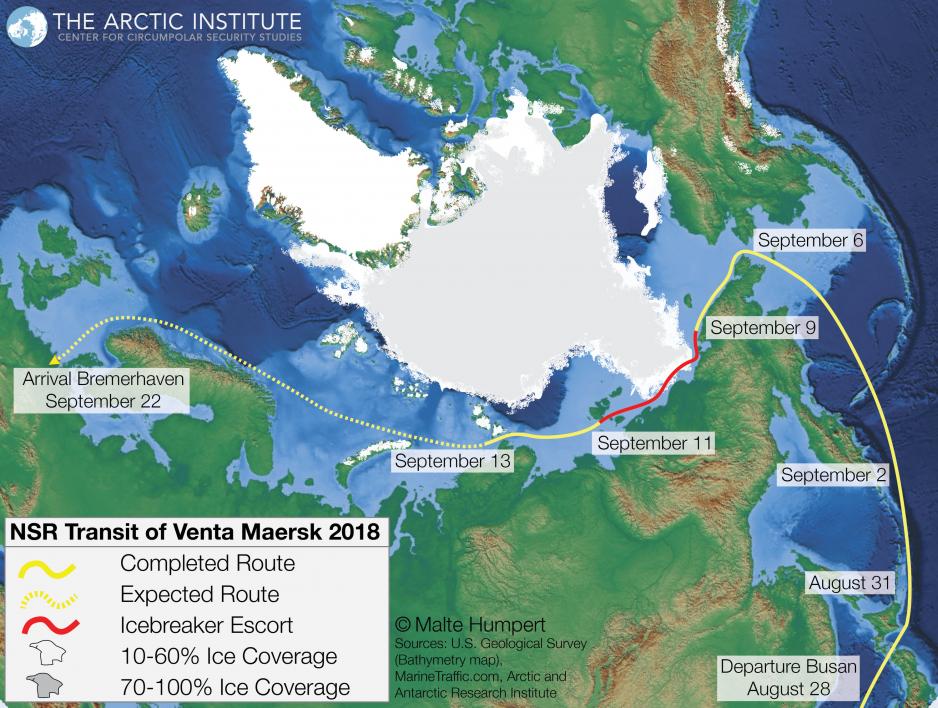Maersk Container Ship Transits Arctic Ocean With Icebreaker Escort

The Venta Maersk following behind the nuclear icebreaker 50 Let Pobedy through icy waters on the Nothern Sea Route. (Photo: Rosatomflot)
Danish shipping giant Maersk is about to complete the first-ever transit of the Arctic Ocean by a container ship. The Venta Maersk traveled through ice-covered waters with the help of a nuclear icebreaker and is expected in Europe within a week.
The Venta Maersk, the first container ship to transit Russia’s Northern Sea Route (NSR), has concluded the most challenging part of its journey through the ice-covered East Siberian Sea.
The vessel, operated by Danish shipping giant Maersk, encountered difficult ice conditions and was escorted by Rosatomflot’s most powerful icebreaker, the NS 50 Let Pobedy, for around 800 nautical miles through the Sannikov Strait and into the Laptev Sea.
A Maersk spokesperson confirmed to High North News that the Venta Maersk entered the waters of the Northern Sea Route last week. There she was met by the 50 Let Pobedy (50 Years of Victory) Rosatomflot’s most powerful nuclear icebreaker as ice conditions were too severe to proceed without escort.
Maersk confirmed that the voyage was proceeding as planned and both crew and systems were operating normally.
The groundbreaking voyage was first reported by High North News last month. Maersk initially voiced interest in sending a container ship along the NSR when it met with Russian officials in November 2017. The company’s CEO Søren Skou confirmed the company’s plans in an interview at the end of 2017.
Thick ice conditions proved too severe to proceed unassisted.
A permit to sail the route was granted by the Russian NSR Administration on July 23, 2018.
Dense ice requires icebreaker escort
The container ship departed Busan, South Korea on August 28, and sailed north-eastward through Japan’s Tsugaru Strait. It entered the Northern Sea Route (NSR) on September 7 sailing at a steady 13 knots.
Despite the fact that the Venta Maersk is part of a brand new generation ice-class 1A feeder container ships capable of operating in unconsolidated ice up to 1 meter, thick ice conditions proved too severe to proceed unassisted.
It encountered dense ice concentrations west of Pevek and joined up with 50 Let Pobedy on September 8. Over the next three days the convoy traveled close to shore avoiding ice floes reaching down from the central Arctic Ocean. Sailing speeds declined to an average of 10.5 knots and were as low as 8 knots during September 10.
After passing through the Sannikov Strait and entering clear waters in the Laptev Sea the icebreaker steamed ahead to Murmansk for repairs and the Venta Maersk continued on its own.
The vessel now passes through mostly clear waters in the Kara Sea before entering the Barents Sea and traveling down the North Sea to its initial destination of Bremerhaven where it is expected on September 22 before sailing onward to Saint Petersburg.

The voyage of the Venta Maersk from Asia to Europe and ice conditions along the Nothern Sea Route. (Illustration: Malte Humpert)
Rosatomflot, operator of Russia’s fleet of nuclear icebreakers, confirmed that the convoy took the shortest possible route and that the escort occurred without any incidence.
East Siberian Sea Remains Dangerous
Ice conditions are commonly most challenging in the East Siberian Sea a new study recently confirmed. This requires vessels to travel close to shore to avoid the ice. However, the waters there are also as shallow as 10 meters preventing larger ships to travel close to shore. This combination of frequent summer ice and shallow waters close to shore creates a choke point for shipping.
"Due to shallow straits, the bigger – and most economic - container vessels can’t pass, the route is only usable part of the year, and even in the summer season ice can delay journeys, making it impossible to guarantee just-in-time deliveries," confirms Arild Moe, Senior Research Fellow at the Fridtjof Nansen Institute.
A Headache for Russia
The fact that even ice-class vessels frequently require icebreaker escorts during the height of the summer shipping season exemplifies the volatility of shipping along the NSR. This is not good news for Russia and its main provider of icebreaking services, Rosatomflot.
A new generation of icebreakers build specifically to keep rapidly growing traffic on the route flowing, has been delayed by at least a year prompting authorities to investigate if the lifespan of the four existing and aging nuclear icebreakers can be extended for a second time to fill a likely gap in icebreaking services.
As Russian newspaper Kommersant reports the NS Arktika which was supposed to enter into service in May 2019 has been delayed until at least April 2020 due to problems with the manufacturing of the steam-turbine. Subsequent icebreakers of the same series Sibir and Ural were expected to follow in 2020 and 2021 but are likely equally delayed.
This places in doubt Russia’s ability to provide continuous services, especially during the winter months. With the production of liquefied natural gas (LNG) at Novatek’s Yamal LNG facility ramping up, it is expected that more than 200 voyages by LNG tankers will require lengthy icebreaking services annually by the beginning of the next decade.

